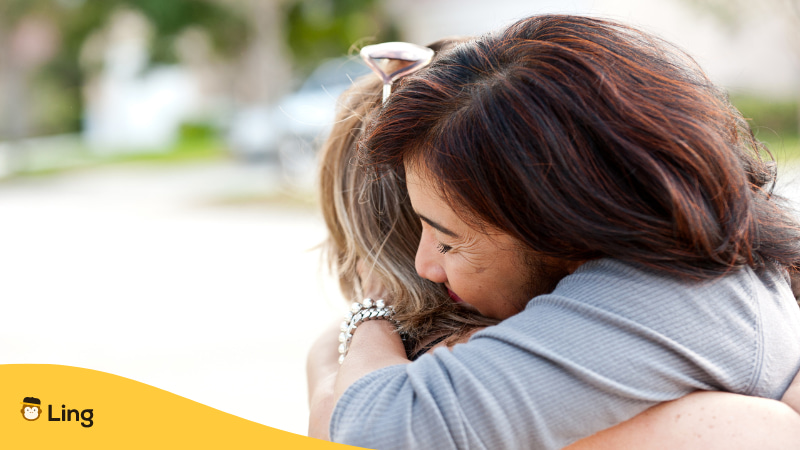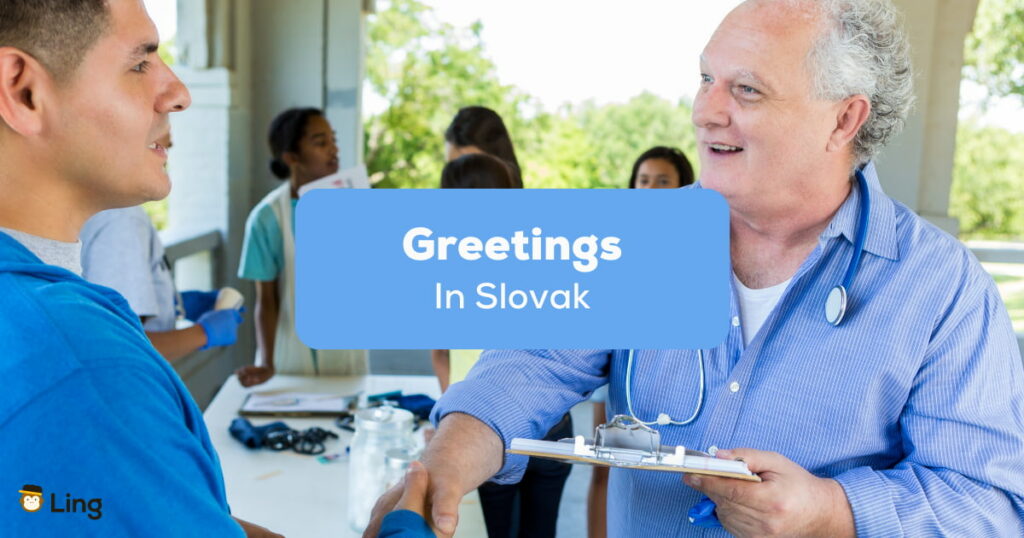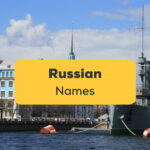Have you ever wondered how to say Hi in Slovak? Slovaks greet each other very often, and it is considered a little bit rude not to respond! Logically, basic greetings in Slovak are something you should know if you are planning to visit this interesting country.
Or you want to impress your friends as you learn a word or two in their native language. So, let’s talk about the most common greetings and goodbyes. Let’s explore the beautiful Slovak language.
What Are The Formal Greetings In Slovak?
| English Translation | Slovak Language |
| Good morning | Dobré ráno |
| Good afternoon | Dobrý deň |
| Good evening | Dobrý večer |
| Good night | Dobrú noc |

When Should You Use Formal Greetings In Slovak?
There are many greetings when you have the exact time and date in Slovak.
You can use Dobré ráno in the morning until 9 am.
Dobrý deň is usually an excellent greeting to say from 9 am until approximately 6 pm.
Dobrý večer is a greeting you should use after 6 pm.
Meanwhile, Dobrú noc is a thing you say only when a person is going to sleep.
You can use “Dobrý deň” or a short form “Dobrý” in almost all formal conversations or official places. For example, when you enter:
- the shops
- the offices
- the schools
- the restaurants and cafés
- or any other place where formal communication is required
When addressing formally, either in an email or at school, you should use the titles instead. Attach these titles after their name in Slovak.
| English Translation | Slovak Language |
| Mr. | pán |
| Mrs. | pani |
| Ms. | slečna |
Here are some examples of formal greetings:
Dobrý deň, pán Peter. (Good afternoon, Mr. Peter.)
Dobré ráno, pani Jauková. (Good morning, Mrs. Jaurová.)
Don’t forget to include their job titles in Slovak when you are greeting them during emails, letters, or during conferences and meetings.
What Are The Informal Greetings In Slovak?
| English Translation | Slovak Language |
| Hello | Ahoj |
| Hi | Čau |
There are lots of other greetings which you can use among friends and have similar meanings. However, those words are considered Slovakian slang words. Those are, for example, “serus, ahojky, nazdar, čauko.” You can use these words to create a fun and relaxed atmosphere.
When Should You Use Informal Greetings?
You can use the most useful informal greetings when you meet with:
- the family
- the friends
- the youngsters
- or people of the same age (usually under 30 years of age)
Here are some examples of informal greetings:
Ahoj, Anna. (Hello, Anna.)
Čau, Martin. (Hi, Martin.)
Slovak Words To Recapitulate
We use the informal “Ahoj” at any time of the day for hello and goodbye. The word is known to some as the sailor’s greeting. It is commonly believed that it was they who introduced it into the Slovak language. The word “Čau” is only used for goodbye and comes from… yes, you got it. It was originally an Italian word, “ciao” that we took over.
When we talk about formal greetings, it is a little bit more complicated as we use different phrases for each part of the day. The word “dobrý” means “good,” and its ending changes depending on the gender of the following noun. The endings are –ý for masculine, -é for neutral, and -u for the feminine in the fall used for the greetings (Accusative – remember your Latin classes?).
Unlike English, the Slovak language doesn’t have a specific time when we have to switch from one to another – it all depends on how you feel. So, you can use “Dobré ráno” (or “Good morning”) until 10 am or until noon, generally for the first few hours after waking up. “Dobrý deň” (or “Good day”) is used for the majority of the day, and “Dobrý večer” (or “Good evening”) is used towards dinner time, which is at around 6 pm in Slovakia. “Dovidenia” could be translated as “until the next time we see each other” and is used as a goodbye when we are with the person.
If we only speak to the person on the phone, we have to use the word “Dopočutia,” which translates as “until the next time we hear each other.” As the difference between the two is minor, I sometimes come across Slovaks using only “Dovidenia” regardless of the situation.

How To Ask “How Are You” In Slovak?
Let’s talk about the most common Slovak phrases used to ask and respond, “How are you?”
| English Translation | Slovak Language |
| How are you? (plural, formal) | Ako sa máte? |
| How are you? (singular, informal) How are you doing? | Ako sa máš? |
| I am fine. | Mám sa fajn. |
| I am very good. I am great. | Ako sa máte vy? A čo vy? |
| What about you? (singular,informal) | Ako sa máš ty? A čo ty? |
| Is everything all right? | Je všetko v poriadku? |
| It is going fine. | Ide to. |
| Not really good. | Nie veľmi dobre. |
| Not good. Very bad. | Nie dobre. Veľmi zle. |
| I am very good.I am great. | Mám sa veľmi dobre.Mám sa super. |

How To Say “Goodbye” In Slovak?
Just like any greeting word, in Slovakia, you can say goodbye in a formal or informal way.
Here are some formal greetings:
| English Translation | Slovak Language |
| Goodbye! | Dovidenia! |
| Goodbye! | Majte sa! / Majte sa pekne! |
| Goodbye! | Hore zdar! |
| See you soon! / See you later! | Do skorého videnia! |
| Have a nice day! | Pekný deň prajem! |
And some informal greetings:
| English Translation | Slovak Language |
| Goodbye! | Maj sa! / Maj sa pekne! |
| See you soon! / See you, then! | Vidíme sa! |
| See you tomorrow! | Vidíme sa zajtra! |
| Bye! / Bye-bye! | Čau! |
| Have a nice day! | Pekný deň prajem! |
In Slovakia, it is important how you say goodbye during phone calls. You can say “Dopočutia” or a short form “Dopo” when ending a phone call.
What about saying good night in Slovak? You can use the word Dobrú noc instead.
Slovakian Example Dialogue
Anna: Dobrý večer, pán Kováč! (Good evening, Mr. Kováč)
Martin: Dobrý večer, slečna Juríková. Ako sa máte? (Good evening, Ms. Juríková. How are you?)
Anna: Ide to. Ďakujem. A vy? Je všetko v poriadku? (It is fine. Thank you. What about you? Is everything all right?)
Martin: Áno. Mám sa fajn. Ďakujem. (Yes. I am fine. Thank you.)
Anna: Výborne. Dovidenia, pán Kováč. (Great. Goodbye, Mr. Kováč.)
Martin: Do skorého videnia, slečna Juríková. (See you later, Ms. Juríková.)
Fill In The Blanks Exercises About Greetings In Slovak
Fill in the blank spaces with the right answer. To be 100% correct, make sure to set your keyboard to Slovak.
– dobrú noc – pekný deň prajem – mám sa super – čau – veľmi zle – slečna – dobrý deň – ako sa máte – dobré ráno – mám sa dobre –
| English | Slovak |
| Good morning. | |
| Good night. | |
| How are you? (formal) | |
| Good afternoon. | |
| I am fine. | |
| Have a nice day. | |
| Hi! | |
| Ms. | |
| Very bad. | |
| I am great! |
Learn More About Slovak With The Ling App
If you want to do more exercises like the one above, you should use a language-learning app. The Ling app can be an excellent solution for you if you want to learn the Slovak language in an easy, fast, and fun way. That way, you will have the opportunity to learn basic words and phrases in Slovak and many more useful expressions in this interesting language.
Where can you download it, you say? It’s on the Play Store or App Store. With just a few clicks, you’re up for the next great journey that you’ll feel happy and satisfied with. Start learning languages with Ling!



































































